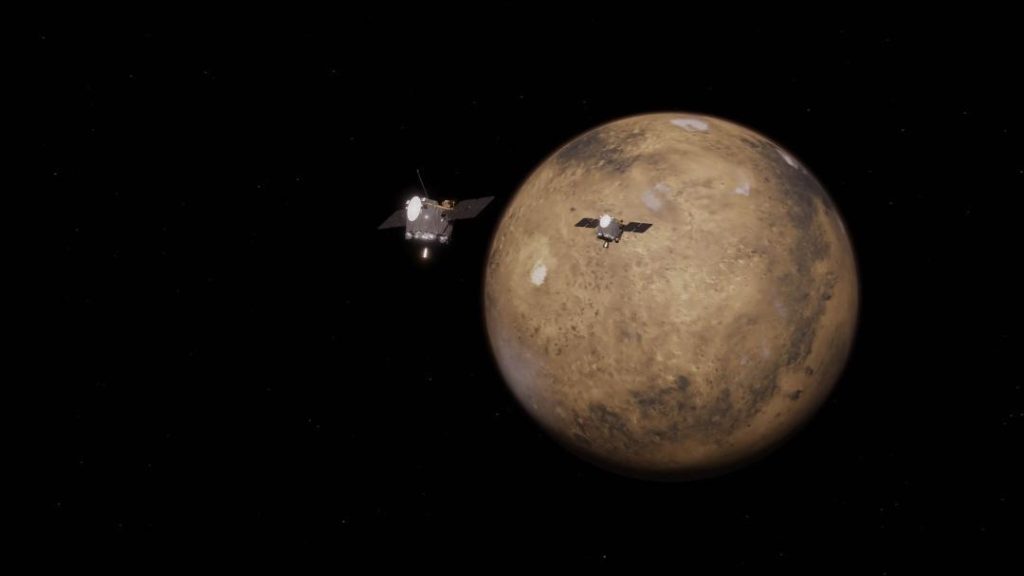
NASA to launch 2 spacecraft as part of ESCAPADE mission on Nov 12
The National Aeronautics and Space Administration (NASA) is all set to launch two spacecraft, Blue and Gold, as part of the Escape and Plasma Acceleration and Dynamics Explorers (ESCAPADE) mission on November 12. This ambitious mission aims to study the effects of solar wind on the magnetic field and atmosphere of Mars, providing valuable insights into the planet’s climate history. In this blog post, we will delve into the details of the ESCAPADE mission, its objectives, and what we can expect from this exciting new venture.
The ESCAPADE mission is a collaborative effort between NASA and the University of California, Berkeley, with the primary goal of understanding how the solar wind interacts with the Martian magnetic field and atmosphere. The two spacecraft, Blue and Gold, will be launched into Earth’s orbit, where they will spend a year before embarking on their journey to Mars in 2027. This prolonged orbit around Earth will allow the spacecraft to test their instruments, communicate with each other, and ensure that they are functioning as expected.
Once the spacecraft reach Mars, they will enter into orbit around the planet, where they will begin their primary mission of studying the effects of solar wind on the Martian magnetic field and atmosphere. The solar wind is a stream of charged particles emanating from the sun, which can have a significant impact on the magnetic fields and atmospheres of planets. By studying how the solar wind affects Mars, scientists hope to gain a better understanding of the planet’s climate history and how it has evolved over time.
One of the unique aspects of the ESCAPADE mission is that the two spacecraft will orbit Mars simultaneously, allowing them to map out how energy and matter move around the planet. This will provide scientists with a comprehensive understanding of the complex interactions between the solar wind, the Martian magnetic field, and the atmosphere. By studying these interactions, researchers hope to reveal clues about Mars’ climate history, including how the planet’s atmosphere has changed over time and what factors have contributed to its current state.
The ESCAPADE mission is also significant because it will provide scientists with a unique opportunity to study the Martian magnetic field in unprecedented detail. The Martian magnetic field is much weaker than Earth’s, and it is not generated by the planet’s core, as is the case with our own planet. Instead, the Martian magnetic field is thought to be generated by the interaction between the solar wind and the planet’s crust. By studying this magnetic field, scientists hope to gain a better understanding of the Martian interior and how it has evolved over time.
The launch of the ESCAPADE mission is a significant milestone in the study of Mars and its climate history. The mission has been years in the making, and it represents a major collaborative effort between NASA and the University of California, Berkeley. The mission’s principal investigator, Dr. Robert Lillis, has stated that the ESCAPADE mission will provide scientists with a “unique opportunity to study the Martian magnetic field and atmosphere in unprecedented detail.”
The ESCAPADE mission is also an important step in the ongoing exploration of Mars, which has been a major focus of NASA’s planetary science program in recent years. The agency has sent several robotic missions to Mars, including the Curiosity rover, which has been exploring the planet’s surface since 2012. The ESCAPADE mission will provide scientists with a new perspective on the Martian environment, complementing the data collected by these previous missions.
In conclusion, the launch of the ESCAPADE mission on November 12 marks an exciting new chapter in the study of Mars and its climate history. The mission’s two spacecraft, Blue and Gold, will provide scientists with a unique opportunity to study the effects of solar wind on the Martian magnetic field and atmosphere, revealing clues about the planet’s past and helping us to better understand its evolution over time. As we look to the future of space exploration, missions like ESCAPADE remind us of the importance of continued investment in scientific research and the many wonders that await us in the vast expanse of our solar system.
News source: https://www.newsbytesapp.com/news/science/nasas-escapade-mission-to-launch-today-how-to-watch/tldr




